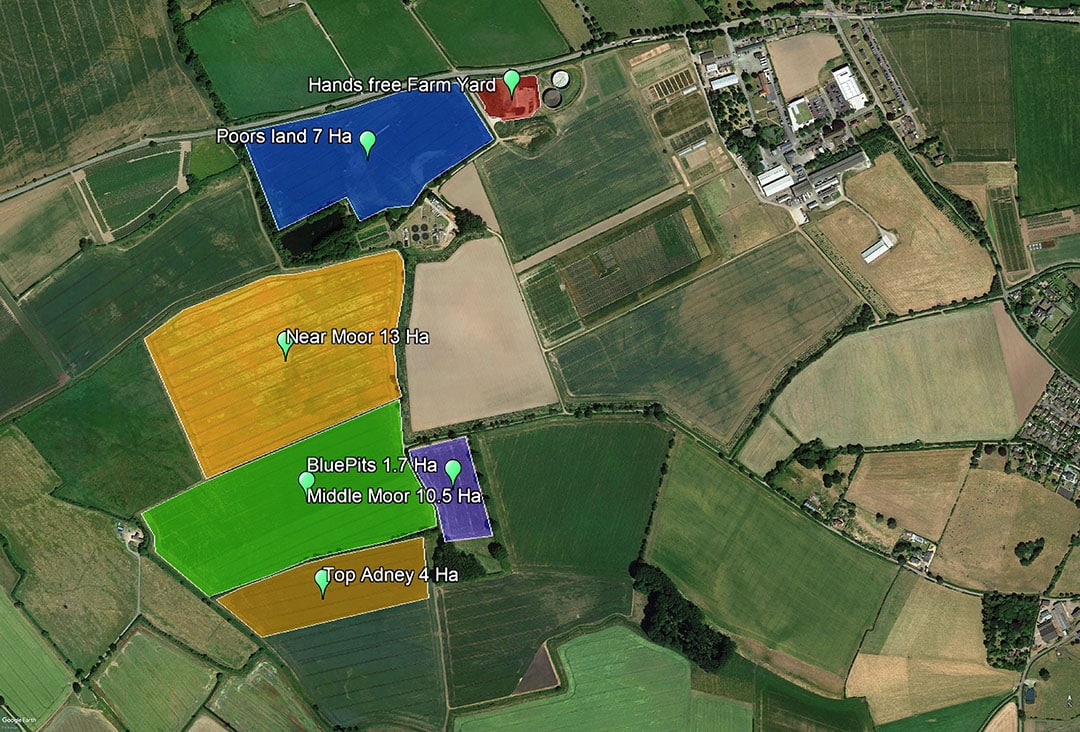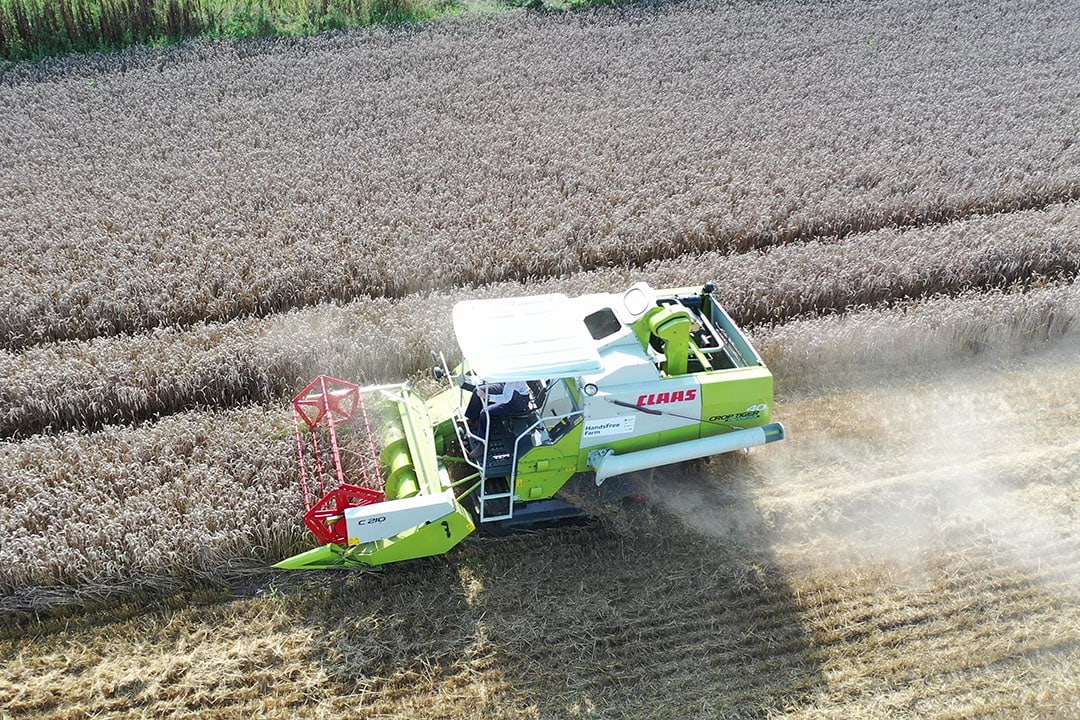Hands Free Farm: On the road to autonomous farming – Part 1

As the ambitious Hands Free project at Harper Adams University in England moves towards its last harvest, we look back at past achievements and follow the latest developments. With commercial robots now at work in a range of operations, we find out where research into autonomous operations will go next. In this, the first in a series on the pioneering Harper Adams University Hands Free autonomous farming projects, we look at how it started and has developed during the past five years.
In 2017 researchers from Harper Adams University used entirely autonomous operations to grow and harvest a crop of barley in a 1ha field – a world first. After this success they have since honed their techniques and expanded their operations across a 35ha ‘Hands Free Farm’.
“While we are acknowledged as being the first to use entirely autonomous operations across a whole season to grow a combinable crop, we were quite aware that others were doing similar things, but behind closed doors. What set us apart, and what we wanted to do, was to show the world what is possible,” says Kit Franklin a Senior Lecturer in agricultural engineering and principal investigator for Hands Free Farm at Harper Adams.
Also read: Hands Free Farm to become UK’s first autonomous farm
“In 2016 my colleague, Jonathan Gill, and I realised it was completely feasible to do this using existing technology. Precision Decisions, bought into our vision from the start and has supported us all through Hands Free Project. We also received collaborative funding from Innovate UK.
“During that autumn and winter we assembled and converted the equipment, sowed the crop in the spring and harvested it in the summer. We proved it was not only possible, but also using relatively simple equipment,” he explains.
Autonomous operations
In that first year they grew a 4.5t/ha crop of spring barley without any human entering the field, with crop ‘walking’ to assess weeds and diseases carried out by drone. The main machines, an Iseki compact tractor and a 25-year old combine, were on one hand basic by modern standards, but on the other represented the state-of-the art.
These machines, updated with electronic actuators to replace the operators, carried out ten different agricultural operations, including drilling, spraying and fertiliser applications.
For autonomous control the pair obviously turned to DGPS for positioning, along with freely available ‘open source’ software, commonly used for controlling drones. This included, Pixhawk autopilot and Mission Planner, which is compatible with a range of mapping systems.
Text continues below video
Back in 2017, most farmers and even some manufacturers were predicting driverless tractors would not appear on farms for more than 20 years. “I was often asked when we will see driverless tractors working in the fields? I always replied, ‘by the middle of the 2020s’. And I stick by that date (2026), it’s already happening – there are now autonomous, robotic machines working commercially in fields not far from our university campus,” says Kit.
Today, if farmers are asked when they think they will see driverless tractors on farms most usually reply: five years.
Hands Free Farm
Despite the success of Hands Free Hectare’s first year, there were the inevitable questions about how it would actually work in real life and comments such as ‘it’s an experiment’, ‘it would be impossible on my farm’, ‘does it work in irregularly-shaped fields’ and so on…
To address these legitimate concerns the team, working with partners Farmscan Ag, Precision Decisions and Agri-EPI Centre, decided to expand its operations to 35ha. This ‘Hands Free Farm’, comprises five differently-shaped fields with sizes ranging from 2ha to 13ha, which more realistically represent actual farming practices.
The ‘Farm’ also includes trees, telegraph poles and 1.5km of footpaths (public rights of way in the UK), which the autonomous vehicles need to negotiate. Working outside the constrains of a fenced-off 1ha plot also raises some important safety issues.
“Our operations already comply with the ‘Code of Practice governing trialling automated vehicles technologies in public’. But, at this time, there are no rules for commercial robotic operations.
“Similarly there was no insurance policies covering driverless machines, so we started discussing this with the NFU Mutual – a large insurance provider to farmers,” he explains.
Text continues below image

Safety standards
In December 2020, to help autonomous operations to progress and work on farms safely and legally, the team organised a webinar to discuss rules, regulations and the possibility of a Code of Practice, with representatives from the Health & Safety Executive, Agricultural Engineers Association, Institution of Agricultural Engineers and other interested parties.
During the past 18 months they have also been working closely with the British Standards Institute (BSI), which is now preparing: BS 8646, Use of Crop Robots in Agriculture and Horticulture – Code of practice.
* Codes of Practice in the UK supplement and support regulations. Although it is not a statutory requirement to follow them, they may be used in criminal or civil proceedings as evidence that a statutory requirement has been contravened.
Autonomous fieldwork
Although 2020 should have seen the Hands Free Farm harvesting its expanded area, unprecedented wet weather flooded the fields in autumn 2019, delaying drilling. Then, just as they planned to start, Covid-19 struck, bringing an end to operations.
While it may be thought driverless tractors would be one of the few operations unaffected by the pandemic, the team actually requires a ‘driver in charge’ and ‘spotters’ to work safely. The fields, however, were sown with cover crops – providing another research opportunity.
The team spent the time preparing for harvest 2021, including converting a Claas Crop Tiger 40 combine on Terra Tracs with 2m wide header to work autonomously. At the same time, the original Hands Free 38hp, TLE 3400 Iseki tractor was joined by another – a TG 6405 also 38hp, both fitted with hydrostatic transmissions.
As we will discover in future reports, the size and power of the equipment is an important part of the research. As well as looking at the how this reduces soil compaction, the team are also investigating the efficiency and capabilities of running a ‘swarm’, or a number of smaller machines, compared with fewer, much larger machines.
“Without the need for a human operator the economic motivation for using larger and larger machines disappears and farming with swarms of robots becomes an attractive alternative,” explains Kit.
Text continues below image

Analysing data
Data collected from Hands Free fieldwork is being analysed by Harper Adams’ Global Institute for Agri-Tech Economics (GIATE). “We have proved that it is technically possible to farm using autonomous machines. This work by our colleagues at GIATE is now studying the economic feasibility of robotic farming,” he adds.
The main aims of the GIATE study are to help engineers and entrepreneurs identify the most profitable crop automation alternatives, guide farmers in their decisions about using crop robotics and inform policy makers about the costs and benefits of crop robotics.
The next article in this series looks more closely at how Hands Free Farm’s work shows small autonomous machines help reduce compaction, improve precision and work smaller areas efficiently.
Join 17,000+ subscribers
Subscribe to our newsletter to stay updated about all the need-to-know content in the agricultural sector, two times a week.



